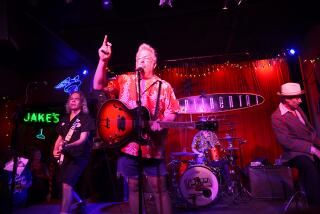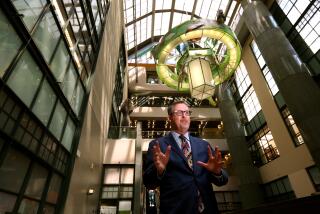The Story of the Lost Library : Nixon: Whittier failed three times on bids to build a repository for the resigned President’s archives.
- Share via
Nestled in the Whittier Hills sits a ridge-top plateau of pristine, prime real estate with a view of the Pacific on a clear day. The city of Whittier first sought to make this the home of a Nixon library more than two decades ago.
And again seven years ago.
And four more years ago.
But today, the champagne toasting the dedication of the $21-million library flows in Yorba Linda, Nixon’s birthplace and now-chosen resting place for the former President’s selected archives.
“We were terribly shocked,” former Whittier Mayor Victor Lopez said recently of Nixon’s decision to locate his private library elsewhere. “It would have been a boost to Whittier, Whittier College and the whole thing. We were terribly disappointed.”
Gene Chandler, another of the city’s former mayors, added: “We always figured that Whittier was his home.”
It is easy to understand Whittier’s claim to the 37th President. Although Richard M. Nixon was born in Yorba Linda, it was in Whittier that he spent his high school and college years. He met his wife in Whittier and practiced law here. And Whittier Republicans helped him start his political career, a successful bid to unseat Democratic incumbent Jerry Voorhis in a congressional district that encompassed the city and nearby communities.
Nixon entered Whittier as a child; he left it as a figure in national politics.
“We felt we had a complete inside track historically,” Chandler said, “with Whittier representing most of his life. It wasn’t to be.”
Whittier’s first effort to claim the library began shortly after Nixon’s 1968 presidential triumph over Vice President Hubert H. Humphrey. Whittier College helped to lead the bid for the library, which enjoyed strong community support.
“His presidency was important at the time to the college,” said Joseph Dmohowski, special collections librarian at Whittier College. “It attracted a lot of students to the college.”
The city presented the then-President with a handsome, oversize, leather-bound and cloth-lined tome titled “The Richard M. Nixon Presidential Library, Whittier, California.” It contained pictorial highlights of Whittier and Nixon’s career, intimately connecting the two on thick cardboard pages.
“It would be a great honor to see your presidential library standing on that Whittier hilltop, purchased with hopes just as high,” wrote then-Mayor Keith Miller and Frederick Binder, who was Whittier College’s president.
Local Nixon friends and supporters also commissioned “The Nixon Trail: A Site Feasibility Study for the Richard M. Nixon Presidential Library.”
Prepared by a prestigious architectural firm, the study contained a picture of a three-dimensional rendering of the library, which was envisioned sitting on a ridge among 120 acres of Whittier hillside--above where the city’s landfill is now located.
The proposed complex consisted of two sets of concentric circles terraced down the hillside. There were also artists’ conceptions of the library interior. The central gallery would feature NASA rockets and space capsules, which at the time is what the artists guessed would be remembered about Nixon’s Administration. Indeed, the library study was submitted shortly after the first moon landing in December, 1969.
In addition, the study’s authors proposed a historical trail winding through Whittier that included stops at the site of the favorite son’s old law firm (Wingert, Bewley & Nixon), three schools he attended, four former Nixon residences, the site of his father’s store, the Quaker church and the location of his wedding reception.
Clearly, everything was on course.
Then came Watergate.
Although most Whittier residents remained sympathetic to Nixon, the impetus for the library literally dissolved as the scandal forced Nixon’s resignation in August, 1974. Choosing a location for his archives became a low priority.
“There was no discussion of the library for a long time after he left office,” said Bruce Martin, executive manager of the Whittier Chamber of Commerce. “The trials were still going on. I think everything went on hold.”
“Had it not been for Watergate, (the library) would have been here,” said Clint Harris, a lifelong Nixon friend and Whittier resident who used to scrimmage head to head with the future President on the Whittier College football team.
By 1983, with Watergate nearly a decade in the past, interest in the library had resurfaced and several cities and universities were active competitors for it. Duke University (where Nixon attended law school) and UC Irvine were eliminated, in part because of faculty and student opposition.
Whittier, though, was a finalist for the site, along with Yorba Linda and San Clemente, which was the location of Nixon’s Western White House. This time, Whittier’s offer had shrunk to 20 acres, but it included the same spectacular ridge.
Lopez remembered attending a dinner party at the home of local Nixon boosters Ed and Ruth Shannon. Nixon’s representatives were there, along with most of the City Council.
“It was a gorgeous evening,” Lopez said. “The hills we were overlooking, that was the Nixon site. We talked financing and so forth. We were willing to put in the road, sewage, water and to give them the land. It was all positive. They liked the site, the view and the town.
“When they left that evening, they said, ‘It looks pretty good to us.’ ”
In the very next day’s paper, Lopez said, he learned that San Clemente had been selected. In her personal files, Ruth Shannon said, she has a letter from Nixon describing his vacillation and agonizing.
“He said, ‘If I followed my heart, it would go to Whittier.’ He felt it should be at San Clemente because of his years at the White House,” Shannon said.
By 1986, however, an unexpected problem had thwarted the San Clemente plans, and the search for a library site was on again. Whittier officials began their third and final bid for it.
At one point, the city wooed Nixon representatives by pitching a tent and a display at the proposed site, Chandler said. But for the most part, the lobbying went on behind the scenes.
City officials “were trying to keep this low key because we’d been disappointed twice before,” Martin said.
And once again, it was not to be. In fact, Yorba Linda’s city manager recently confessed that his city had an inside track after the San Clemente deal fell through. “They came to us and asked if we were interested,” Arthur C. Simonian said.
It helped that the city already had preserved Nixon’s birthplace as a historic site and could offer an adjacent land parcel for the library.
So Yorba Linda, a sleepy Orange County suburb, is looking forward to an estimated 350,000 library visitors a year and the tourist dollars they will leave behind. Whittier, a city still trying to rebuild from the October, 1987, earthquake, will sorely miss the income and the prestige, city officials said.
Most of Nixon’s close friends and supporters from Whittier were treated to sneak previews of the shrine to the former President. Almost to a person, they loved everything--save for its address.
“But we’re happy for Yorba Linda. They did a great job,” Martin said diplomatically.
Meanwhile, the Whittier Chamber of Commerce is already at work on Plan B, a revival of the Nixon trail idea. Martin figures that some library visitors would venture a side trip to Whittier. Perhaps they’ll even stay at the local Hilton. He’s sure the chamber could arrange for shuttle service from Whittier to the library.
Martin said, “We’re trying to take a positive approach to the whole thing.”
RICHARD NIXON’S TIES TO WHITTIER Year: 1922 Event: Family moves to Whittier. Year: 1926-30 Event: Attends Whittier High School. Year: 1930-34 Event: Enters Whittier College, majors in history, graduates with honors. Becomes student body president, a champion debater and an enthusiastic benchwarmer on football team. Also helps found a college fraternal organization, acts in student plays and sings with the Glee Club. Year: 1937 Event: Joins first law practice in Whittier. Year: 1938-47 Event: Serves as assistant city attorney. Year: 1940 Event: Marries Pat Ryan, a high school teacher living in Whittier. He met her during tryouts for a community play. Year: 1946 Event: At the request of Whittier Republicans, enters and wins Congressional election. First child, Tricia, is born in Whittier. Year: 1950 Event: Wins election to Senate. Source: Whittier College
More to Read
Sign up for Essential California
The most important California stories and recommendations in your inbox every morning.
You may occasionally receive promotional content from the Los Angeles Times.











